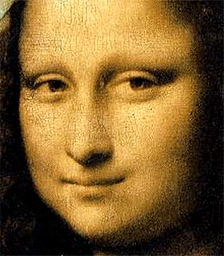

| Visitors Now: | |
| Total Visits: | |
| Total Stories: |

| Story Views | |
| Now: | |
| Last Hour: | |
| Last 24 Hours: | |
| Total: | |
Chet Raymo, “Many Dreams Have Been Brought To Your Doorstep…”
by Chet Raymo
“Yesterday we followed Leonardo da Vinci to his final abode at Amboise in France, in the shadow of the king’s palace. Before we leave him there, let’s ponder for a moment the thing he was perhaps most famous for: the Mona Lisa’s smile. No kidding. A zillion words have been written about Leonardo, and I would guess that the smile tops the chart for volume of interest. Even at age fourteen, I laid abed in a dreamy reverie listening to Nat King Cole croon her praises:
․
You’re so like the lady with the mystic smile.
Is it only ’cause you’re lonely, they have blamed you,
For that Mona Lisa strangeness in your smile?”
․
Or is this your way to hide a broken heart?
Many dreams have been brought to your doorstep,
They just lie there and they die there…”
Lyrics like that would be considered silly by kids today, but to a hopelessly romantic teenager in 1950 Nat’s sexy voice churned up the promise of bliss in the presence of the eternal feminine. Of course, at that age, I wouldn’t have known a “mystic smile” from a come-hither or a sneer.
The person who turned on the spigot of words about the enigmatic expression was Sigmund Freud, in his Leonardo da Vinci and a Memory of His Childhood, in which he provided a psychoanalysis of the artist, focusing, as you might expect, on the child’s oral fixation on his mother. Freud guessed that Leonardo rediscovered his mother’s smile in the person of Mona Lisa del Giocondo, a Florentine noblewoman whose portrait he was commissioned to paint, and employed the same feature on every figure, female and male, that he subsequently painted.
Since Freud, the Mona Lisa’s smile has inspired a cascade of psychological and even physiological interpretation (look at Mona Lisa with your left-hand peripheral vision). Contradiction seems to be the key. The smile has been described (by various scholars, all male) as “tenderness and coquetry, modesty and secret sensuous joy,” “the charm of deceit, the kindness that conceals a cruel purpose,” and “good and wicked, cruel and compassionate, graceful and feline.” Freud himself professes to find in the beautiful Florentine’s expression “the most perfect profile of women; the contrast between reserve and seduction, and between the most devoted tenderness and a sensuality that is ruthlessly demanding – consuming men as if they were alien beings.” Yipe!
None of this was apparent to me at age fourteen. Women were then deeply mysterious, but my image of them was altogether a product of my own fervid adolescent imagination. It wasn’t until mid-life – the early fifties, say – that my fantasies had been finally peeled away to be replaced by utter bafflement. Perhaps significantly, this was the same age at which Leonardo painted the lady Giocondo, and the same age at which Freud wrote his Leonardo essay. That cryptic smile expresses the realization that comes to men at a certain age that they haven’t a clue what makes women tick. For Leonardo, who was perhaps bisexual, the smile swung both ways, from female madonnas to beautiful male youths.
No doubt the women here on the Science Musings porch will have their own interpretation of the Giocondo smile, and they will certainly be wiser than me. After a lifetime of preoccupation with women, I prefer to look at the Florentine lady out of the left-hand corner of my eye, which for various reasons presumably involving “different cells in the retina transmit[ing] different categories of information or ‘channels’ to the brain” simplifies the “mystic” expression to one of benign condescension. Condescension I can live with; the inscrutable contradiction of the feminine is another thing altogether.”
․
Or just a cold and lonely, lovely work of art?”
2012-11-04 17:20:13
Source: http://coyoteprime-runningcauseicantfly.blogspot.com/2012/11/chet-raymo-many-dreams-have-been.html
Source:



